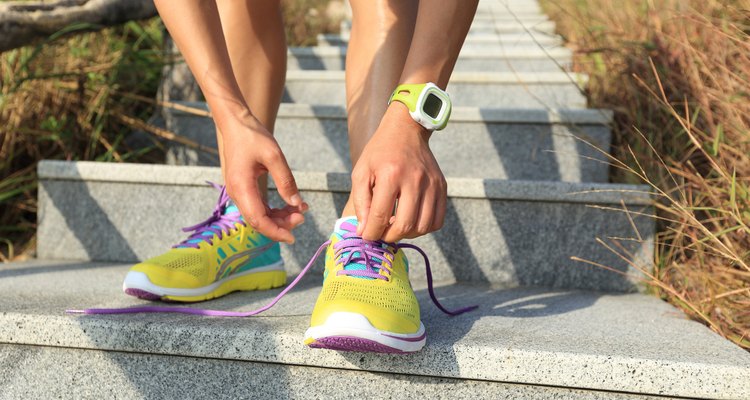
lzf/iStock/Getty Images
An Indian tribe in Mexico noted for speed and endurance, the Tarahumara run marathons over rocky trails with only thin sandals strapped to their feet, according to Chris McDougall, author of “Born to Run.” Compared to the Tarahumara, who enjoy maximum ventilation of their feet, the average athlete wears sneakers and faces the risk of contracting athlete’s foot. By wearing well-ventilated shoes, you can prevent this itchy and irritating foot condition.
Fungus and Feet
Tinea is a skin infection caused by fungus, or dermatophytes, that grow in dead skin, hair and nail tissue and thrive in warm moist environments, such as a damp sneaker after a workout. As a form of tinea, athlete’s foot involves the spread of fungus to the areas between your toes and the soles of your feet. Your feet may discolor, becoming red, and itch, burn or sting. Affected skin may blister, peel, crack or flake. Because this fungus is contagious, if you scratch your foot and then touch other parts of your body, you can unwittingly spread the fungus well beyond your feet.
The Key: Mesh
Ventilation eyelets -- the airholes built into the sides of a shoe -- were a manufacturer’s early solution to enabling air flow in sneakers. In the 1980s, the eyelets were replaced by mesh side panels to provide more ventilation. Today, the upper part -- known as “upper” in sneaker speak -- of a well-ventilated sneaker is almost entirely made of mesh. The more mesh, the more breathable the sneaker will be, according to Fitness Magazine. Plastic or leather can form the sneaker’s frame.
Welded Shoes
In 2008, Nike’s Innovation Lead for Basketball Shane Kohatsu ventured to China on a research trip. He noticed that Chinese street basketball players wore anything but basketball sneakers – hiking boots or cross training shoes -- to beat the heat and endure asphalt. Kohatsu surmised that there must be way to provide players with a shoe that combines two sought-after features – breathability and durability. Nike came up with fabric -- “Hyperfuse” -- consisting of three or more heat-pressed synthetic layers, according to Fast Company. Because the frame and mesh of the shoe are fused, the technology eliminates the need for any stitching. The result is well-ventilated hardy sneaker. While other brands are catching on to this technology, it can be tricky to master, suggests ConceptKicks.
Heed the Lining
Different types of sneaker lining can provide more or less air flow. For example, lining made of goat or sheep skin will give you better ventilation than cow leather, according to Sneaker Report. Some sneakers’ collar linings are created from moisture-wicking fabrics and help to keep your feet dry in the shoe. In addition, sneakers may have antibacterial and anti-friction sock liners, which are designed to ward off athlete’s foot.
Related Articles

How to Repair Sperry Shoes
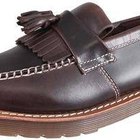
How to Clean Dr. Martens Shoes

The Difference Between Nike Dunks & AF1

What Are Pac Boots?
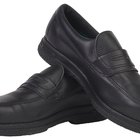
What Are the Benefits of Leather Soles?

How to Stretch out the Tops of Western ...
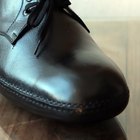
The Best Way to Stretch Patent Leather ...
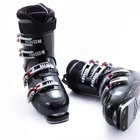
How to Store Ski Boots

How to Clean Airwalk Ugg-Style Boots

How to Clean the Insides of Rubber Boots
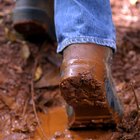
How to Clean Discolored Shoes

Types of Shoe Fabric
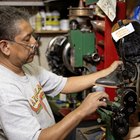
Fixing a Boot's Heel
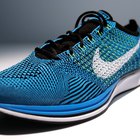
Types of Nike Shoes

How to Stop Clog Shoes From Squeaking
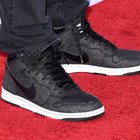
How to Tell Real Shoes Like Airforce ...
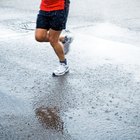
How to Waterproof Your Sneakers

How to Make Wader Boots

What Looks Good With a Gray Suit?

How to Clean High Heels
References
Writer Bio
Kay Tang is a journalist who has been writing since 1990. She previously covered developments in theater for the "Dramatists Guild Quarterly." Tang graduated with a Bachelor of Arts in economics and political science from Yale University and completed a Master of Professional Studies in interactive telecommunications at New York University.
Photo Credits
lzf/iStock/Getty Images